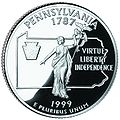| Keystone Symbol | |
|---|---|
 Design of the keystone symbol on the Pennsylvania government's website [1] | |
| Armiger | Commonwealth of Pennsylvania |
| Earliest mention | c. 1890 |
| Shield | two isosceles trapezoids |
| Use | ID cards, road signs, logos of government agencies |
The keystone symbol is the name commonly given to the de-facto state emblem of Pennsylvania. [2] It is a stylized keystone (or capstone), an architectural term for a wedge-shaped stone placed at the top of an arch. [3] The shape consists of two isosceles trapezoids, each with the smaller side facing downward, with one being smaller, more flat, and placed on top of the other. The symbol alludes to Pennsylvania's official nickname, The Keystone State. [4] Although the symbol has not been designated as the official state emblem, the Pennsylvania Department of Community and Economic Development has declared it the "official Pennsylvania government logo". [5] It is also popular for non-governmental purposes. [6]
Contents
The symbol appears on Pennsylvania state route markers, Pennsylvania ID cards, and the logo of each cabinet-level agency of the Pennsylvania government. [7] It is also used in various non-governmental logos, such as that of the Pennsylvania Railroad, Heinz, Little League Baseball, and the National Honor Society. [8]
- Use as a bullet point on modern Pennsylvanian license plates
- Use on state quarter
- Use on official state route markers
Keystone symbols are extremely common in military heraldry. It can be found on the badge of the Pennsylvania Army National Guard, [9] [10] the Pennsylvania Air National Guard, and the now-disbanded Pennsylvania State Guard. Many parts of the Pennsylvanian and United States national army also include keystone symbols on their insignia.
The flag of Shenango Township (in Lawrence County, Pennsylvania) has a keystone symbol on it. The shield is shaped like a keystone symbol on the de-facto coat of arms of the city of Allentown, Pennsylvania, which is placed on the city's official flag and seal. [11] [12] The seal of Keystone Heights, Florida also has a keystone symbol on it. [13]

In 2017 the "Keystone Flag" was designed by Tara Stark, a Pennsylvania resident. [14] The flag incorporates the keystone into a tricolor design using the colors on the coat of arms of Pennsylvania [15] as an intentional callback to the symbolism of the existing flag. [16] The design gained significant attention on social media, but is not currently adopted. [17]
The bookplate of the University of Pennsylvania is in the shape of a keystone symbol. [a] The shield of the coat of arms of the Keystone Central School District is shaped like a keystone symbol. [18]
The seal and burgee of the Erie Yacht Club in Erie, Pennsylvania both have keystone symbols on them. [19]







